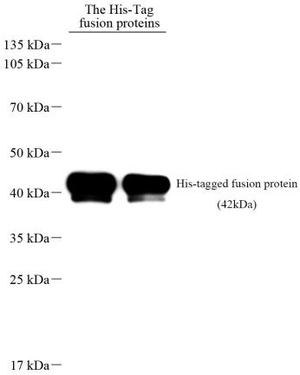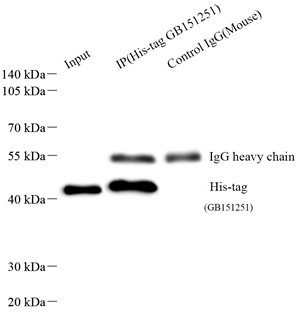Recombinant Anti-His Tag Mouse mAb (100 μl)
| Reactivity: | |
| Applications: | WB & IP |
| Host Species: | Mouse |
| Clonality: | Monoclonal |
| Gene Name: | His Tag |
Synonyms: | 6*His, His Tag, 6histag, 6XHis, HHHHHH, HIS, His probe, His Tag, His-probe, HISTIDINE TAGGED |
Immunogen: | KLH conjugated Synthetic peptide corresponding to HHHHHH (6* His) |
Isotype: | IgG |
Purity: | Affinity purification |
Product Usage Information
WB | Tag (All species) | 1: 2000-1: 5000 | His-Tag fusion protein |
IP | Tag (All species) | 1: 50-1: 200 | transfected HEK-293F cells |
Special note
Epitope labeling has been proved to be an effective method that can be performed on target proteins. Tag antibody can be used in a variety of applications, including ChIP, CoIP, ELISA, FC, IF, IHC, IP, WB and so on.
Background
Protein tags are protein or peptide sequences located either on the C- or N- terminal of the target protein, which facilitates one or several of the following characteristics: solubility, detection, purification, localization and expression. His-tag is often used for affinity purification and binding assays. Expressed His-tagged proteins can be purified and detected easily because the string of histidine residues binds to several types of immobilized metal ions, including nickel, cobalt and copper, under specific buffer conditions. The His-tag antibody is a useful tool for monitoring of the His-tagged proteins, and recognizes His-tags placed at N-terminal, C-terminal, and internal regions of fusion proteins expressed in bacteria, insect, and mammalian cells.
Images
 | Western blot analysis of His Tag (GB151251) at dilution of 1: 5000 |
| Immunoprecipitation of transfected HEK-293F cells lysate using His-Tag(IP: GB151251, 1: 100; Detection: GB151251, 1: 3000) |
Storage
| Storage | Store at -20°C for one year. Avoid repeated freeze/thaw cycles. |
| Storage Buffer | PBS with 0.02%sodium azide,100 μg/ml BSA and 50% glycerol. |

